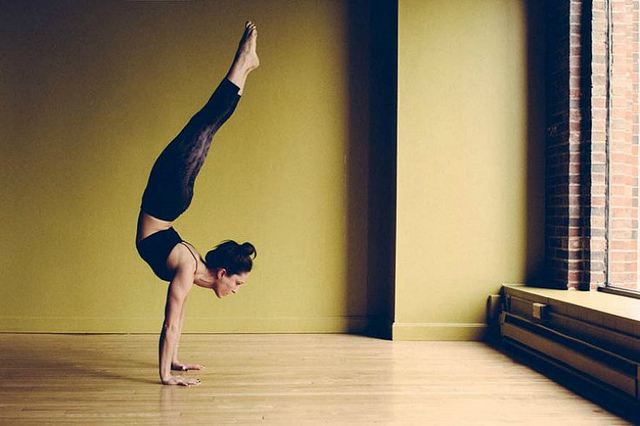Who doesn’t love a fun experiment every once in a while?
If we ever find our minds drifting off in yoga class, or if we feel like we’re in a rut in our practice, it may be time to switch things up a bit. There are a lot of ways to enhance our practice and expand our mind without being disruptive or spending a bunch of extra money. Here are six:
1. Ear Plugs
If we really want to have a different experience in class, try wearing earplugs. This will work especially well if we’re in a Bikram class or any class with set sequencing. A home practice is a great place to give this a go too.
Earplugs will tune out any distracting noises like sweat dripping or people sliding around on their mat. But even more importantly, earplugs will help redirect our attention back to ourselves.
Drowning out any excess noise helps us feel into our body, so we’re more in tune with what’s going on inside, rather than what’s happening with everyone else.
Earplugs will help cultivate a relationship of openness and awareness with ourselves. Fewer interruptions and more connection.
2. Wear Layers
While I don’t recommend doing this in a hot yoga class, wearing layers can change our practice while in a comfortable, room-temperature class. Our bodies will warm up more quickly, and we may find that we can go deeper into each pose.
Creating heat like this keeps our bodies warm throughout the entire class, so even with breaks, we won’t lose that fire that yoga creates within our muscles and joints.
We’ll also sweat a lot more with layers on! This is great for detoxing our bodies from all those toxins we carry around.
In fact, this article from Medical Daily states that sweat not only helps us detox, but it boosts endorphins (makes us happy), lowers the risk of kidney stones, helps fight off bacteria and viruses and can even help clear up our skin!
3. Close Your Eyes
Like earplugs, closing our eyes throughout our yoga practice can help us create a deeper connection with ourselves. However, with our eyes closed, we can’t look around and compare ourselves to anyone else!
It’s not easy to do, especially if you’re someone who has a hard time balancing in certain poses, like so many of us do. But it creates a completely different experience than we’re used to.
Especially if the studio has a mirror, this is a great way to learn how to practice yoga based on how we feel, rather than how we look. After all, that’s what this practice is truly about when it comes down to it—feeling good.
When we spend our time looking around the room comparing ourselves to everyone else, we immediately leave our bodies, defeating the whole purpose of yoga.
But if we’re willing to practice with our eyes closed, and can trust ourselves enough to fall down every once in a while, not only will our practice grow, we’ll create a new kind of relationship with ourselves—one based on trusting that we’ll be okay, even when we’re experiencing discomfort.
If you feel like you’ll want to open your eyes and peek around the room, tie a bandana around your eyes to make sure you won’t be able to cheat!
4. Find a New “Spot”
So many of us love to place our mats in exactly the same area of the yoga studio, every single time. We get comfortable. Maybe our favorite spot is by the window so we can have a nice view outside, or maybe we’re right next to the door, in case we want to run out of class when those core exercises begin.
Wherever you love to be, try going to the opposite spot. Moving our mat to a different space than we’re used to each time will not only create an entirely different experience, but it’ll push us outside of our comfort zone a little bit.
If you love to practice in the very back, try moving your mat to the front row next time. And vice versa if you love to practice at the head of the room.
My favorite place to practice is smack dab in the middle of the room, especially if it’s a jam-packed class. There’s a lot of energy there, like we’re all moving together as a pack.
If we try out a new spot at our next class, we might find that stepping outside of our comfort zone is exactly the step we needed to take!
5. Modify, Modify, Modify
How often do we allow ourselves to have a more relaxed practice? We live in a world of doing more, being more, working more. More, more, more.
When was the last time you let yourself modify your practice? Have you ever modified every pose in a single class?
I hadn’t until recently.
It’s very freeing. Sometimes we show up for yoga because we feel like we should be there. And those are usually the days where our practice feels slow and sluggish.
Next time you feel that way, or even when you don’t, try modifying the poses.
So if you’re in anjaneyasana (crescent/high lunge pose), try putting your back knee on the mat. This will take a little pressure off the muscles in your legs and it’ll open up the front of your thigh and hip flexor of the lowered leg.
Or, for chaturanga dandasana (high-to-low plank), you can drop both knees to the floor and press the tops of your feet and toes against the mat.
This is a great modification if you’re still building strength in your arms, or even if you want a little less intensity in your upper body during your practice.
Have fun with this! Don’t forget that you can incorporate blocks, straps and bolsters for modifications as well. Ask your teacher before class for modifications if you need help coming up with your own.
6. Savasana—the entire time
Who doesn’t love a juicy savasana (corpse pose) at the end of a sweaty class? I know I do.
But taking savasana for the entire class? It just doesn’t happen that often. Savasana can be a profound way to deepen your practice.
I know I’ve struggled with the idea that if I’m in savasana the entire time, I’m not going to get anything out of the class. But it’s often the exact opposite. What if lying in corpse pose actually gives us more?
There’s also the fear of being the only person in savasana for the entirety of the class. If you’re worried about sticking out or offending your teacher, just let them know before class begins that you might be taking savasana for the day.
Chances are, though, this won’t be necessary. As teachers we’re taught to keep an open and accepting mind. Your teacher will probably be flattered you feel relaxed and comfortable enough to do that in their class! If you’re worried about how he or she may react, feel free to give a heads up before class starts.
Taking the time to turn our thinking minds off and wake up our awareness brings us fully to the present moment. We allow our minds and ourselves to expand. We can still take breath cues from our instructor and stay present in our stillness.
Staying in savasana the entire class is particularly beneficial to those who keep a full schedule. Don’t be afraid to take some time for yourself to be quiet. You’ll feel amazing and rejuvenated afterward.
Author: Meera Watts
Image: terri_jane/Flickr
Editor: Emily Bartran











Read 0 comments and reply